
THEODOR HERZL A Memorial - A special memorial book published on the 25th anniversary of the death of Theodor Herzl, edited by Meyer W. Weisgal - New York 1929. Printed on glossy paper.
The book reviews Herzl's private and public life and is accompanied by dozens of rare photos, examples of Herzl's own handwritten letters, and vivid documentation of historical events related to Herzl and his extensive Zionist activity, Herzl in art, Herzl’s diaries, Herzl’s books and possessions after his death and more. Includes a large folded group photo of all the delegates who participated in the First Zionist Congress in Basel in 1897.
320 p. Tears on the cover edges, especially at the top. Wear on the cover. Overall condition good-moderate.

"למען שממות ארצנו" - For the Wilderness of Our Land - Printed letter by the last Chief Rabbi of Kovno, Gaon Rabbi Duber Kahane Shapira regarding raising awareness to purchase land in Eretz Israel and redeem Eretz Israel from foreign hands. The letter was published in Kovno and written in Hebrew! on the 23rd of Elul 1930 after the events of the 1929 riots and reports about the difficult situation in the Eretz Israel reached the exiles. Kovno, Elul 1930.
In his letter, the Gaon describes the difficult situation that prevailed in Eretz Israel at that time after the 1929 riots - "the terrible events of last year in our Holy Land, the horrifying massacre perpetrated by our foes against our holy brothers, " and the British mandatory government preventing Jews from entering the country, as well as the spiritual danger from Zionism. In light of all this, he writes that there is a double and redoubled obligation "for every man of Israel to strive and exert himself to redeem a parcel of land from foreigners, to strengthen and secure the settlements of our brothers and their lives, and to redeem the land". The Gaon adds that "our Sages of blessed memory said: "There is no man of Israel who does not have 4 cubits in Eretz Israel", but these 4 cubits are occupied by strangers, and he must dedicate a significant portion of what God has blessed him with to redeem them", and adds that whoever is unable to purchase 4 cubits in Eretz Israel must take part in contributions to Keren Kayemet (JNF) to at least have a share in redeeming the Land.
Gaon Rabbi Avraham Dov Kahana-Shapira [1871-1943] was a descendant of Rabbi Chaim of Volozhin and Rabbi Alexander Ziskind of Horodna, author of Yesod VeShoresh HaAvodah. At age 43 he was appointed rabbi of Kovno, the second most important Jewish community in Lithuania. He was Kovno community's last chief rabbi, and one of the great Poskim of the 20th century. When World War II broke out, he was in Switzerland recovering from a serious illness. His son Yerucham, who lived in New York, urged him to leave Europe for New York until the end of the war, but he returned from Switzerland to Kovno and refused to abandon his community in its time of need. Throughout the war his son tried unsuccessfully to get him to leave Europe for New York. He passed away in the Kovno ghetto on the 22nd of Adar Aleph 1943 after an illness. He was buried in a large funeral, a life-endangering event in those days. His famous work is "Dvar Avraham responsa"
[1] Leaf. 27x21 cm. Filing holes (reinforced with adhesive paper). Light stains. Good condition.
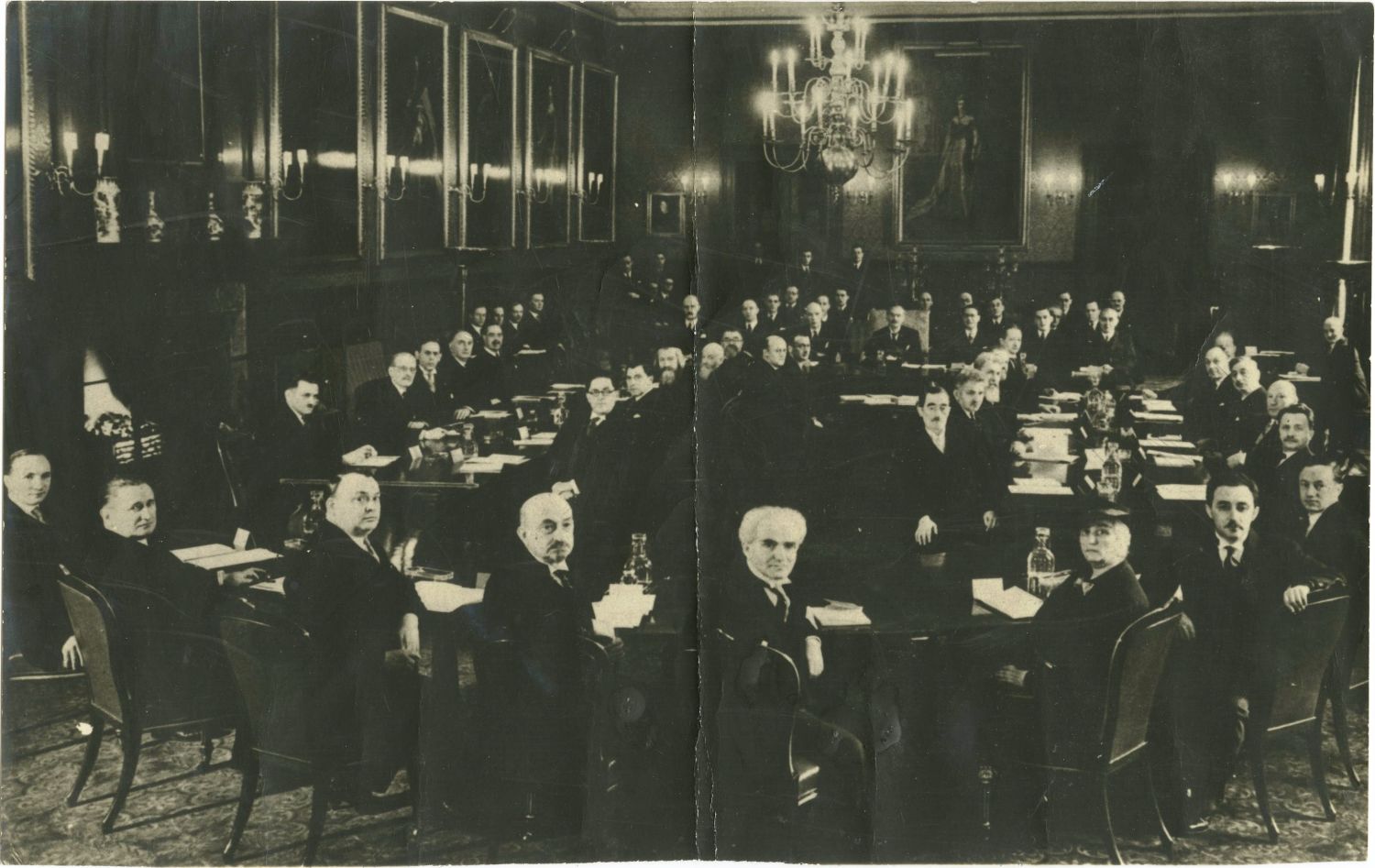
A rare photograph of the Round Table Conference held in London between February 7 and March 17, 1939. Around the table are seen David Ben Gurion, Chaim Weizmann, Moshe Sharet, Yitzhak Ben Zvi, Moshe Bloy, and others.
The Round Table Conference, or by its official name the St. James Conference (known as the London Conference), was a conference that took place between February 7 and March 17, 1939 and was the British government's last attempt to mediate the problem The Jewish-Arab conflict. The source of its official name is the name of the palace in London where it was held. The conference opened on February 7, 1939. From the very beginning, the Arab representatives refused to sit at the same table with the representatives of the Jewish settlement, therefore each of the delegations held a separate meeting of the conference with the British who became mediators. The representatives of the Jews, led by Chaim Weizmann, called, relying on the Balfour Declaration and the British mandate, to allow immigration to Israel, one that would contribute to solving the problem of Jewish refugees in Europe. They also appealed to the English not to leave the Jews "at the blackest hour in the history of the people of Israel". The Arab representatives insisted that there is no connection between the Arab state and the Jews living in the Land of Israel, and that they are ready to recognize the Jews who are already in the Land as a Jewish minority, but in no way approved the continuation of the immigration. On March 15, the British government submitted its plan to the two delegations. Weizmann was not present at this meeting and Ben-Gurion also refused to appear at it. They were not present at the closing meeting of the conference, after it became clear that in light of the British government's proposals, their presence would detract from their dignity. The next day, Weizmann left the Jewish delegation and said: "Everything that happened here was just a passing episode, another upheaval in the series of upheavals known to our people. They had great hopes, and they were partly shattered. They will return and rebuild them. They have waited thousands of years: they will be established in their way for another five years." On March 17, Weizmann sent a short letter to Malcolm MacDonald, in which he wrote: "The Jewish delegation, after carefully considering the proposals submitted to it by His Majesty's government on March 15, 1939, regrets that it is not qualified to accept as a basis for an agreement, and therefore has decided to disband."
Size: 30x19 cm. Crack in the center of the photo. Good condition.

Cabinet photo of Rabbi Yehuda Leib Lichtenstein and his wife Sara (née Eliash) - the father-in-law of Rabbi Ozer Weizman, father of the first president of the State of Israel, Chaim Weizman. Riga, late 19th century.
Size: 17x11 cm. Good condition.

Response to a parliamentary question submitted by MK Avraham Haim Shag to David Ben-Gurion, regarding the soldiers of the Alexandroni Brigade who fell in the Fallujah Pocket in the War of Independence and have not yet been brought for burial. A typed letter on official letterhead paper signed by David Ben-Gurion. Dated July 5, 1949.
In his response Ben-Gurion writes: "The IDF Chief Rabbi is dealing with the issue of the Agunot and prepares the material so that a rabbinical court will be able to release the fallen soldiers' wives from the chains of Igun... For health reasons it is still impossible to transfer the bodies of the soldiers who fell in Fallujah. By doctors' orders, the transfer will only take place in another few months, and the transfer of the bodies will not be delayed even one unnecessary day. The transfer of the bodies will facilitate identification and help release the chains of Igun". Official letterhead paper, 27x21 cm. Filing holes. Very good condition.
Also attached is the parliamentary question itself, submitted by MK Avraham Haim Shag to David Ben-Gurion. May 1, 1949. In the question, Haim Shag writes about the suffering of the parents of some eighty fallen soldiers waiting for their sons to be identified and brought for burial in Israel. Avraham Haim Shag's official letterhead paper 27x21 cm. Filing holes. Very good condition.
Indeed at the end of that year, on December 8, 1949, after a lengthy and painful identification operation led by Rabbi Goren, the fallen soldiers' bodies from the battle were brought for eternal burial in the Nahalat Yitzhak Cemetery.
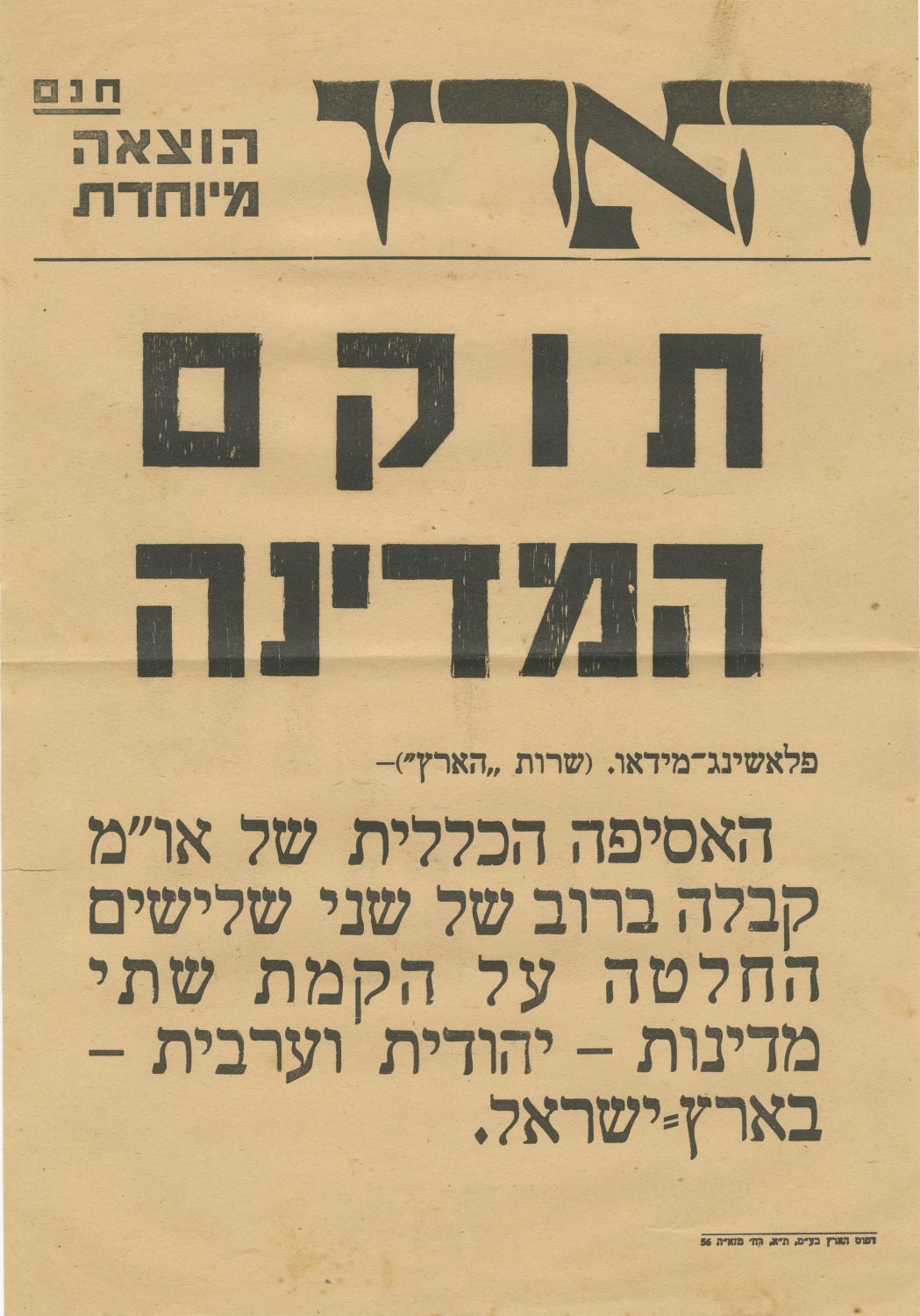
A leaf printed on one side. With the title: "The establishment of the state" - a special issue of Ha'aretz newspaper reporting on the UN resolution passed in November 1947 on the establishment of two independent states in the Land of Israel - a Jewish state alongside an Arab state. Published on the day of the UN decision!
"The UN General Assembly passed a two-thirds majority decision on the establishment of two states - Jewish and Arab - in the Land of Israel."
[1] page. 35x24 cm. Good condition - very good.
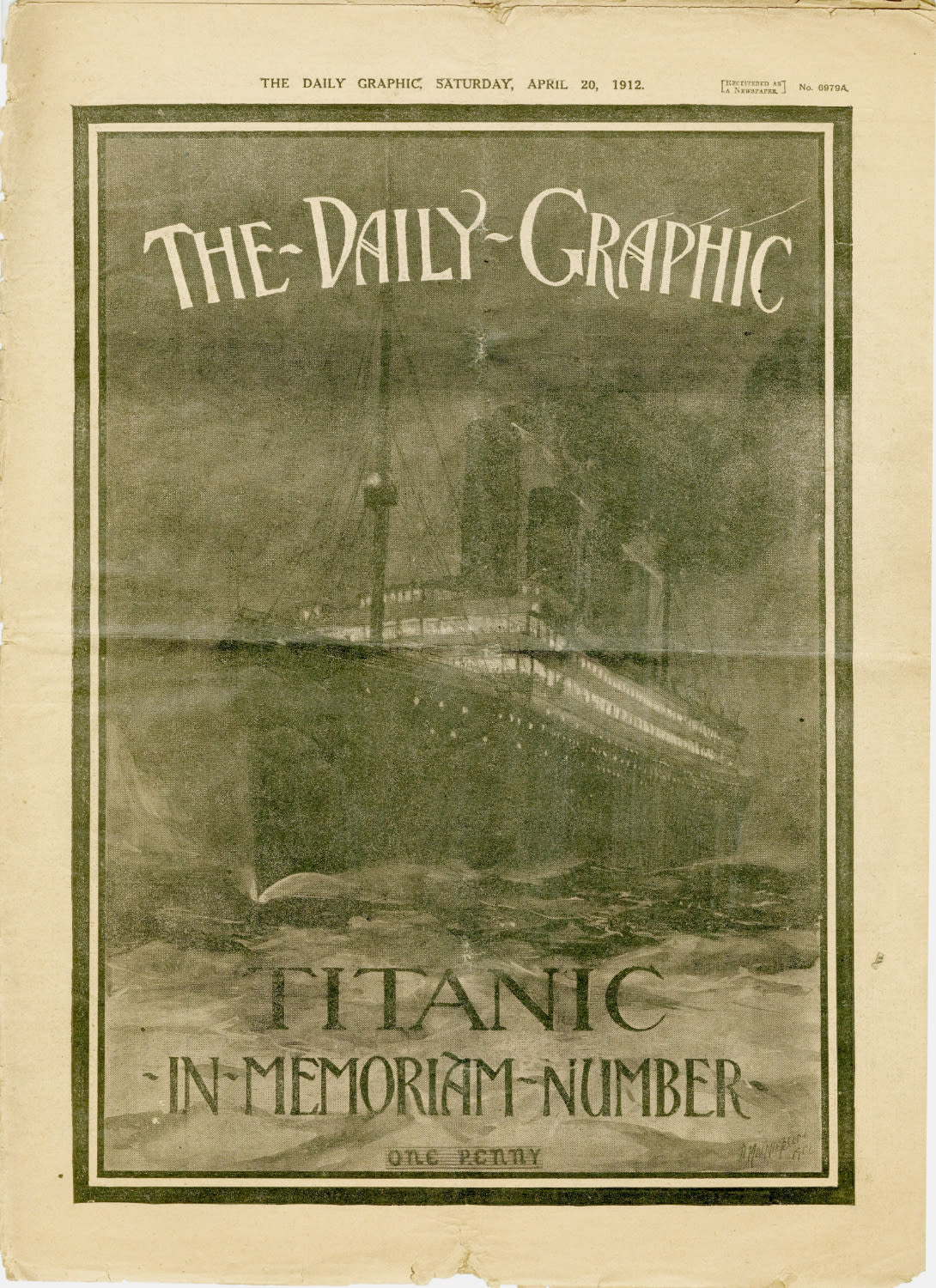
The Daily Graphic Newspaper In Memoriam of the Titanic - April 20, 1912 - five days after the sinking of the most famous ship of the 20th century - Last photos of the ship before its sinking, pictures of the victims, and a review of the results of the disaster, and more. Rare.
A Daily Graphic historic issue entirely devoted to the Titanic disaster in articles, analysis, and especially photos. Including: A diagram of the location of the disaster, articles on aid for widows and orphans, an extensive article with all the details known at that time about how the disaster occurred, pictures of the victims, a last photo of Captain Smith taken on the ship's deck, as well as of his sons and daughters left orphaned, photos of the location where the disaster took place, photos of memorial services held in memory of the victims, relatives of the victims in the tense hours in London after the disaster became known, the agonizing wait of the crowds for the names of the victims which were constantly updated, and more.
20 p. 43 cm. Light tears on the margins of some pages. Open tears on last page with light damage to text without affecting photos on inner side of page, and with damage along photo on last page, loose spine. Condition good - moderate.
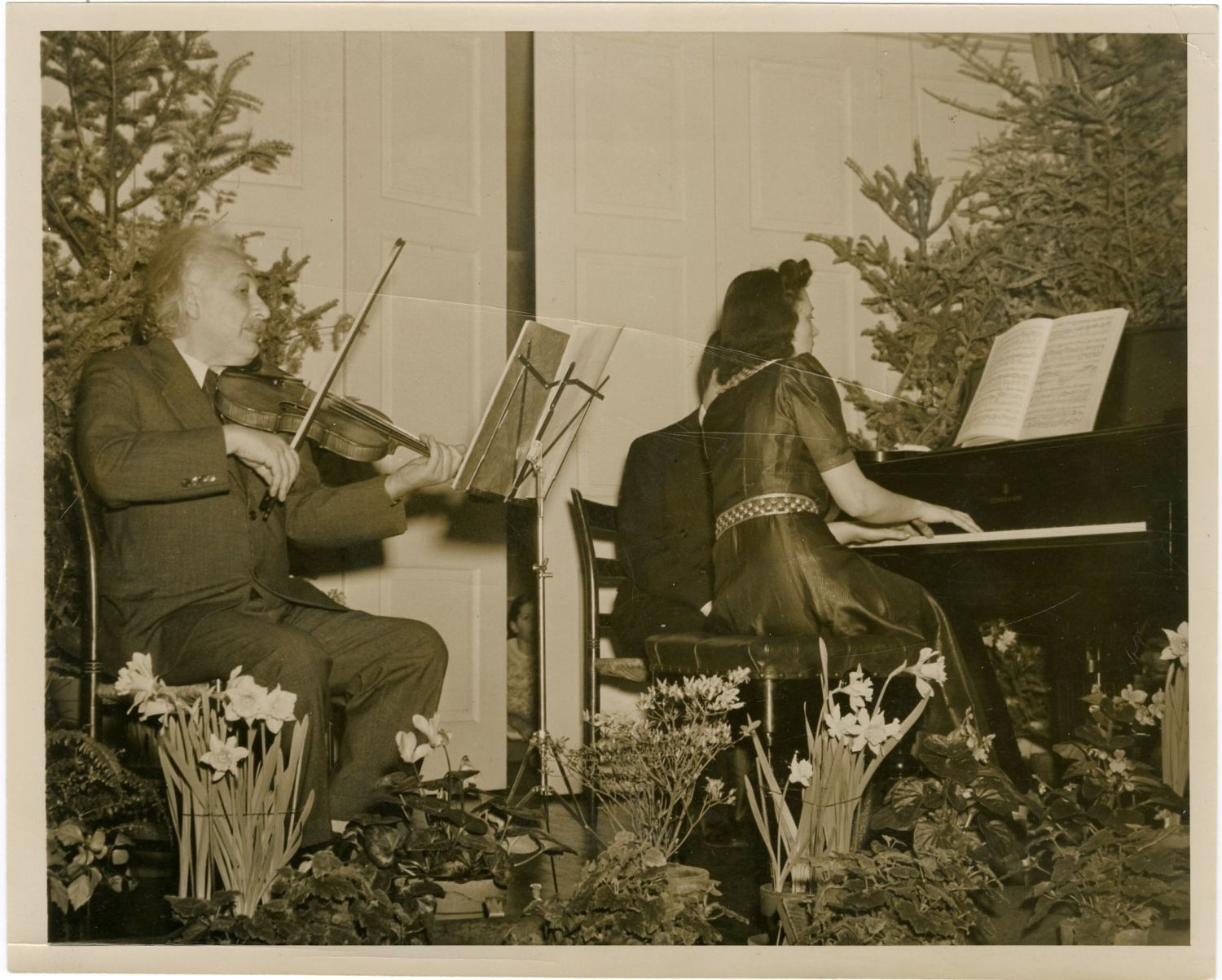
Photograph of Albert Einstein playing the violin alongside Gaby Casadesus (1901-1999, wife of French composer Robert Casadesus) playing the piano at the day club for war refugees , 1941. Signed on back with Acme News Pictures agency ink stamp.
Attached: a complete issue from the New York Times with a photo of Einstein playing the violin at another event.
The concert was organized by the AFSC - American Friends Service Committee that promoted social justice. During the war they provided aid to displaced children, and this event took place for them in Princeton. It was one of the rare public performances by Einstein, who since childhood rarely performed publicly. The audience includes some 300 people, including many prominent figures like Eleanor Roosevelt and Adele Stevenson. The violin Einstein played was donated by the Stradivarius Society.
Attached: A complete issue [!] of the New York Times November 10, 1933, where on page 24, it shows Einstein holding a violin playing together with a group of famous musicians he hosted at his home in Princeton with his wife standing behind him.
Photo: 22x18 cm. Slight crack in the upper right corner on the border of the white margins. Two cracks in the upper part of the photograph a little above the center along its length (visible in the picture) Otherwise good condition.
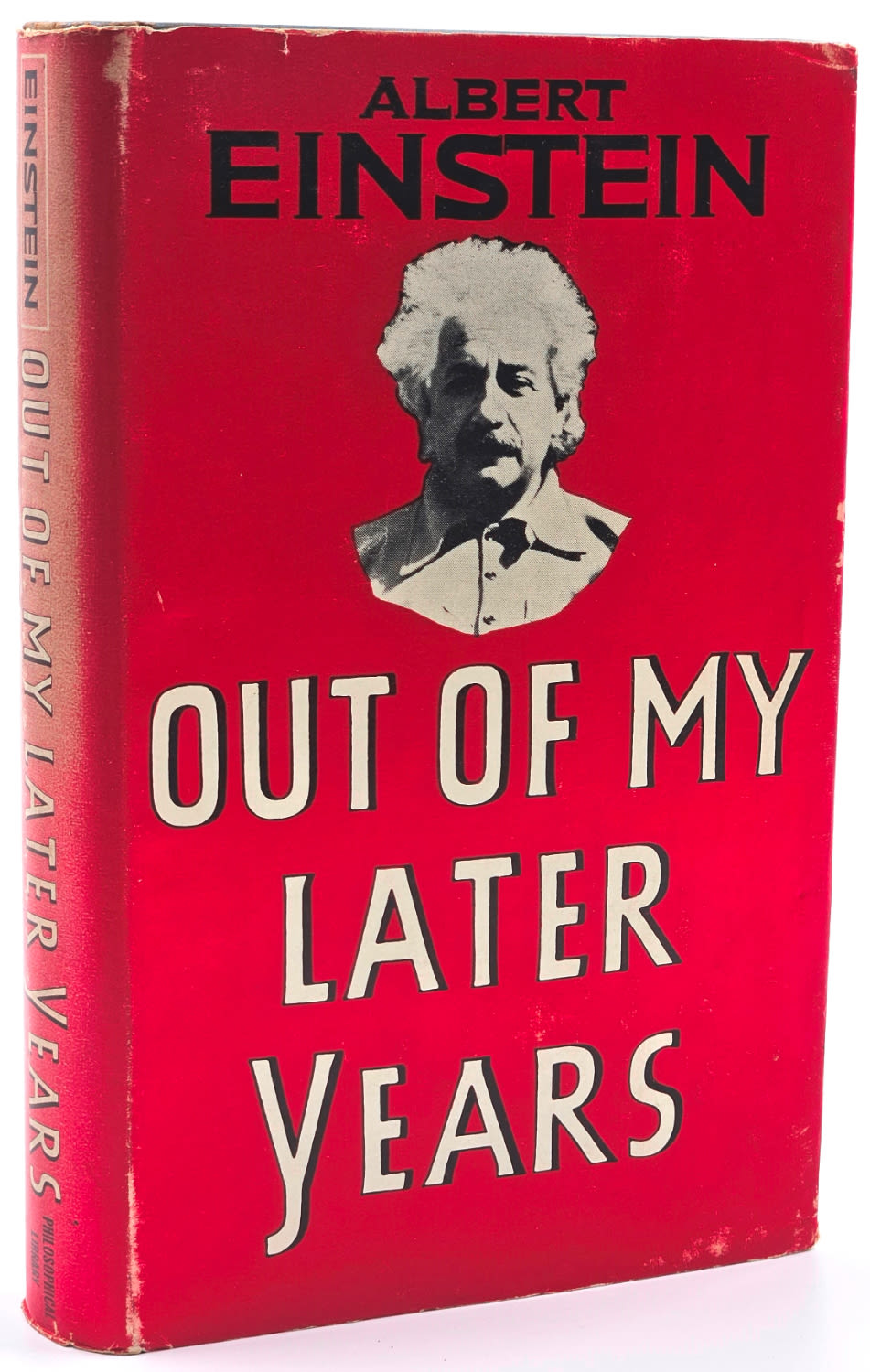
Out of My Later Years - by Albert Einstein. Published by Philosophical Library, New York, 1950 - first edition. Rare copy with the original paper jacket depicting Einstein's portrait taken by the Jewish photographer Lotte Jacobi.
A collection of essays written by Einstein in the last 15 years of his life between 1934-1950. The essays deal with his attitudes towards religion, education, human faith, politics, Jewish affairs, war and peace, fundamentals of physics, and more. In several chapters of the book Einstein explains the theory of relativity in simple terms accessible to everyone. The book provides insights into Einstein the philosopher, scientist and man. The essays are reproduced in their exact words without any editing.
In known copies of the first edition, the dust jacket has no image at all. Before us is a rare copy with a dust jacket bearing Einstein's portrait taken by the Jewish photographer Lotte Jacobi. It is unclear why the publisher chose to design the dust jacket differently. We have seen more than one dust jacket design for copies of the first edition, some with no image, some in black and white with a drawing of Einstein, and some with a different lettering style. However, before us is a rare copy with a dust jacket featuring Einstein's portrait as photographed by Jacobi.
Lotte Jacobi [1896-1990] was a Jewish German-American photographer who photographed many of her famous acquaintances including Käthe Kollwitz, Wystan Hugh Auden, Eleanor Roosevelt, Albert Einstein, Martin Buber, Marc Chagall, Chaim Weizmann and others. Some regard her work as a "chronicle of an era" because she photographed so many important 20th century figures.
251 p. 19 cm. Hardcover with original dust jacket. Very good condition.
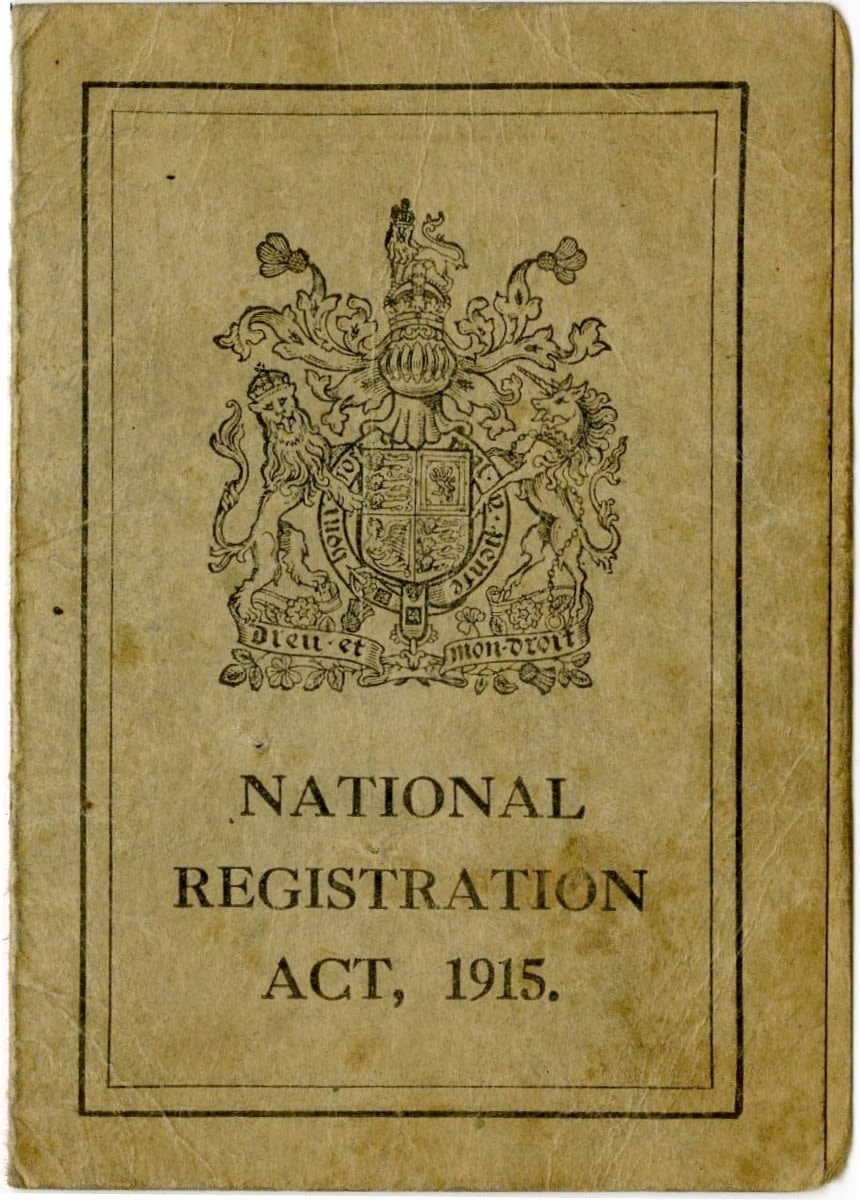
National Registration Act 1915 - Occupation registration card of the Jew Reuven Cohen according to the "National Registration Act 1915". England, March 13, 1917. The card confirms that Reuven Cohen is registered in the "National Registration" enacted in 1915, his signature, and an ink stamp from March 13, 1917. On front, the British royal coat of arms, ink stamps, and Cohen's signature.
The "National Registration Act 1915" was an Act of Parliament in Britain passed on 15 July 1915. The Act mandated registration by occupation of every citizen in the country between the ages of 15 and 65. Its purpose was to try to resolve the crisis in vital industries created by the mass recruitment for the war. In addition, the registration was intended to streamline the deployment of the workforce, so that the government would know all the professions in which the person engages and allocate people to vital industries. The registration system was used to collect statistical data on the number of working women, which of them were single or married (for women, the occupation was coded from 1 to 30, where 1 is "household duties" and 30 is "other"). Over 48 million people registered under the Act, approximately 95% of Britain's civilian population.
Bernard Mallet, the Registrar General of England, set up a system whereby on registration day, August 15, 1915, everyone had to fill out a form with personal details, field of occupation, and any other work they were skilled in and able and willing to do. The forms were organized by each local authority. After registration, personal cards like this one before us were distributed to each registrant, confirming that he was registered by the government. At the end of the war the government relied on the records to assist those affected by the war. After the war, all records were destroyed, and cards like this were simply discarded, hence their rarity.
Pocket certificate, 4 pages, 11 cm. Good condition.
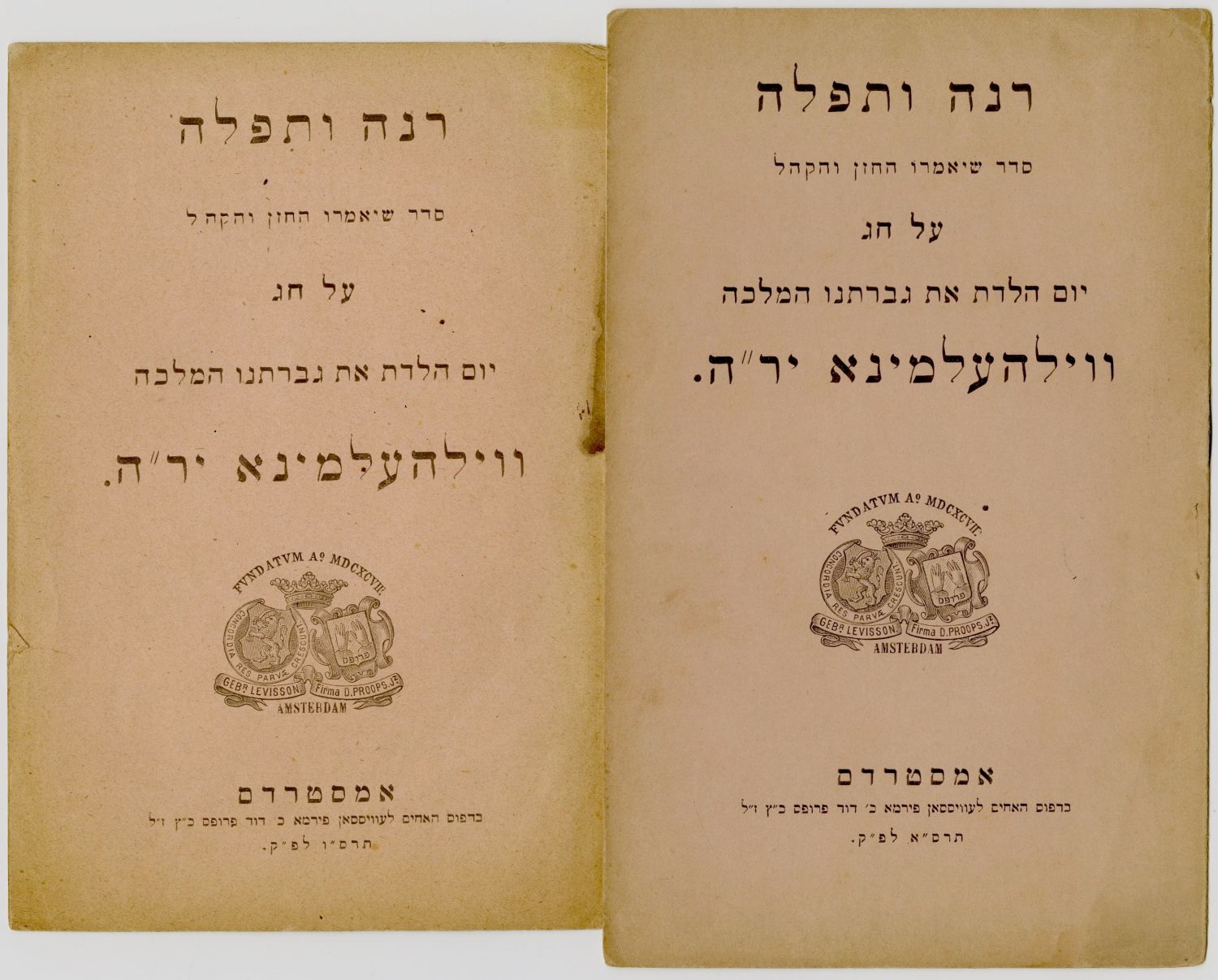
Rina and Tefila Seder to be recited by the cantor and the Kahal on the holiday of the day of the birth of our Lady Her majesty Queen Wilhelmina - two prayer and thanksgiving booklets on the occasion of the birth of Wilhelmina Queen of the Netherlands - 1901 and 1906.
Psalms, "לך ה' ריבון העולמים... הרימונו קולנו בקול תודה וזמרה עלי יום הלדת גברתנו המלכה ווילהעלמינה ירום הודה...", LeShlomo El-kim Mishpatecha, HaNoten Teshua LeMelachim, Halleluya.
Queen Wilhelmina of the Netherlands [1880-1962] was the most popular and popular queen of the Dutch royal dynasty. She reigned in the Netherlands for fifty-eight years, longer than any other Dutch monarch. Wilhelmina was a strong supporter of the Jewish community, and her wedding was attended by many Jews from all communities of Israel (more than 300,000 people in total stood in the streets of The Hague to watch the procession). Throughout her reign, Queen Wilhelmina supported the Jewish community – appointing Jews to high-ranking positions in her government and speaking out against anti-Semitism on many occasions, assisting Jews, including during the Nazi occupation during World War II.
Stain on the cover of the booklet from the year 1906. Both booklets in good condition.
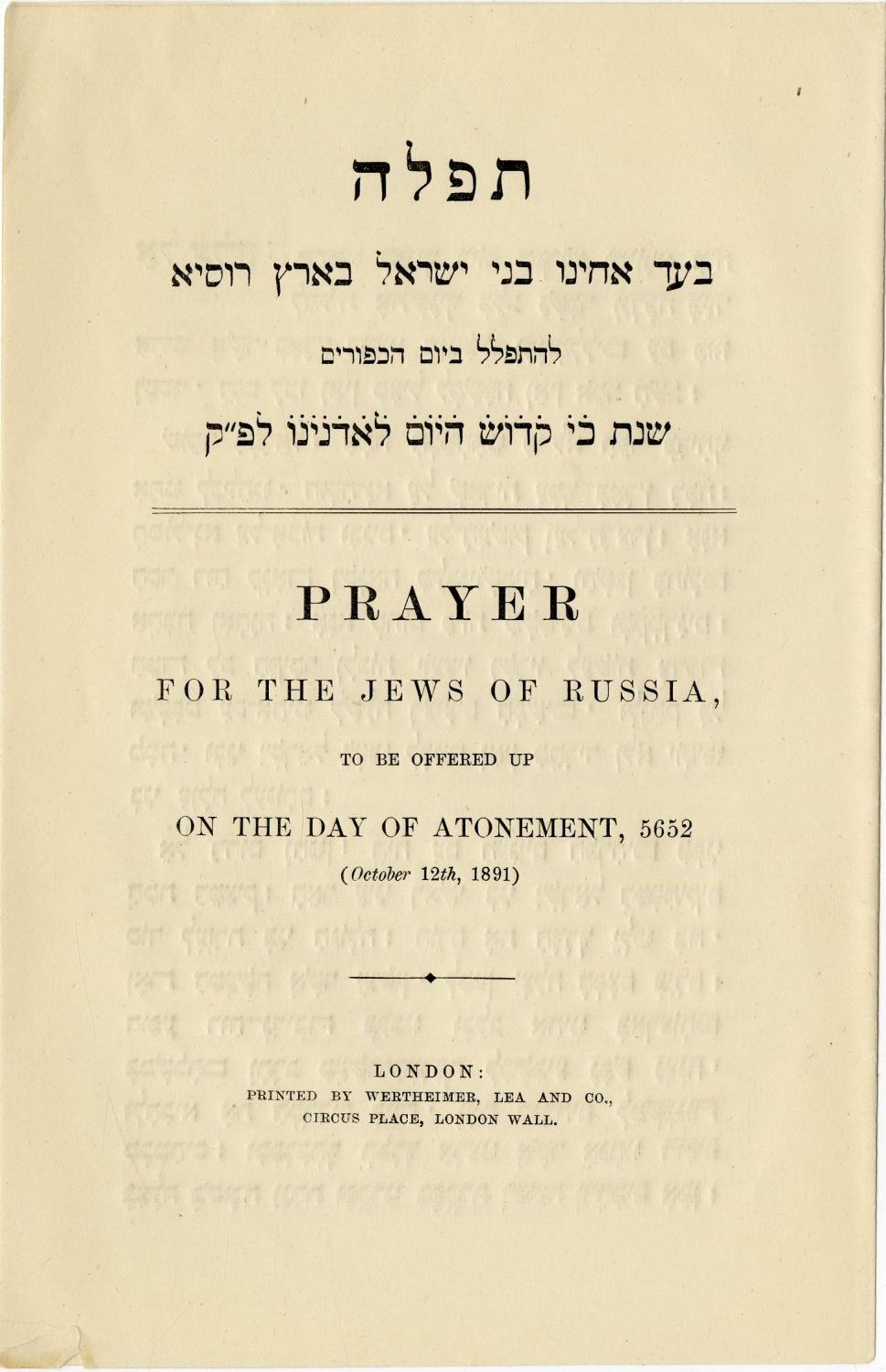
Prayer for our brothers Bnei Israel in the land of Russia to be recited on Yom Kippur. London 1891. Hebrew and English.
A special version composed in the London community, to pray for the Jews of Russia during the pogroms at the height of Yom Kippur in 1891! - "...We have come before You on this holy and awesome day...on behalf of our brothers in the land of Russia who suffer violence and wretchedness through looting and robbery... Seal the mouths of slanderers and accusers... Turn the heart of the Tsar and the hearts of his advisors and ministers to do righteousness and justice with our brothers...", and a prayer for the success of the escapees and immigrants in their escape.
On March 28, 1891 a wave of pogroms against the Jews of Russia erupted. The violence stemmed from the economic distress in the country, and the influence of folk tales prevalent in Russia about Jews. The violence began in Moscow, and quickly spread to other cities across Russia. The violence led to the deaths of hundreds of Jews, with thousands more injured, and also caused extensive damage to Jewish property. The Russian government did nothing to stop the violence, and even cooperated with the rioters in some cases. These pogroms led to a wave of Jewish immigration to Palestine and the United States.
[4] pages 22 cm. Very good condition.
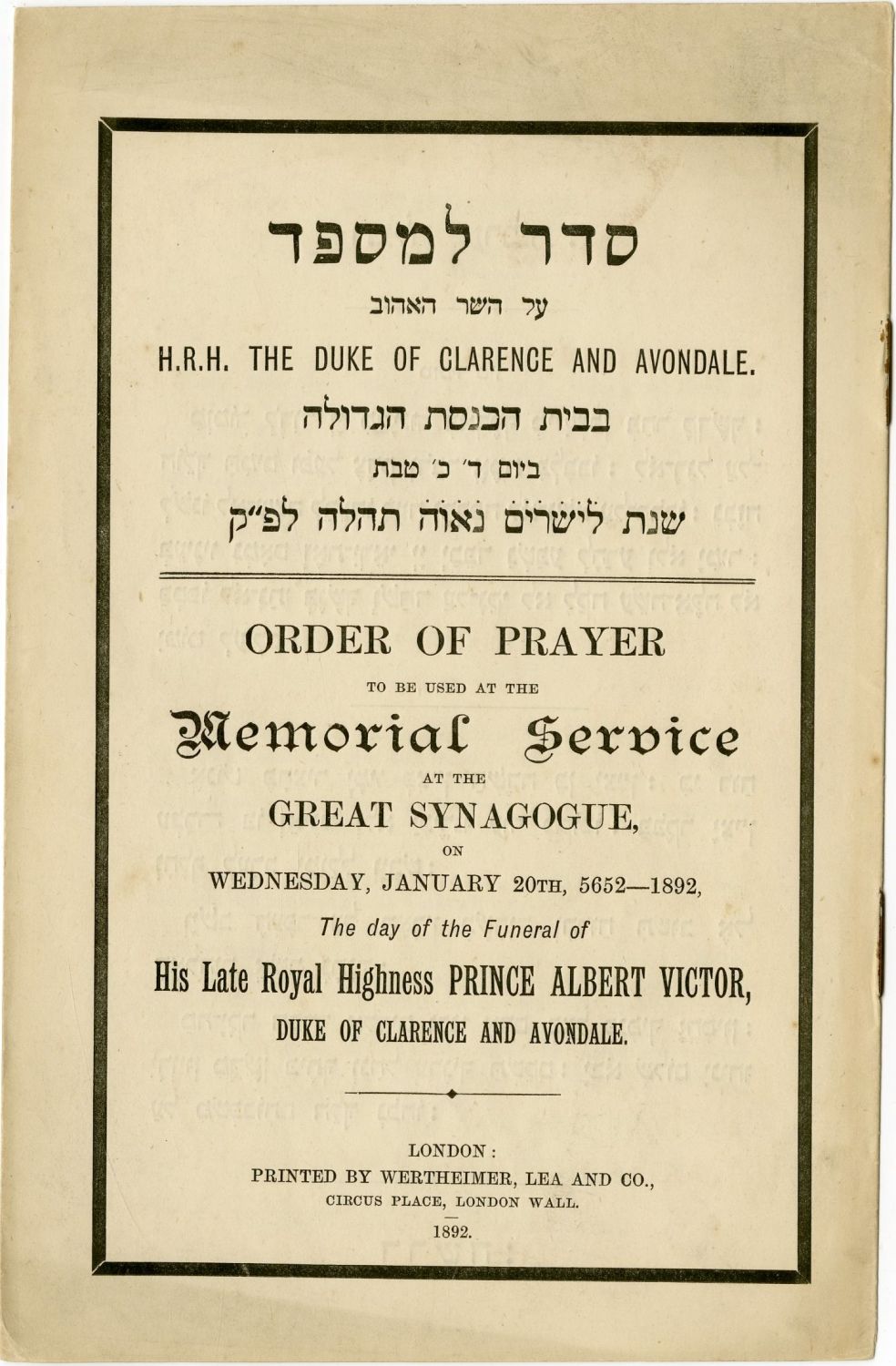
Seder for the eulogy on the Beloved Prince Albert Victor, Duke of Clarence and Avondale, London 1892. Hebrew and English page by page.
Prayer and eulogy for Prince Albert Victor on his passing, about a week after his death (the prince died on January 14, 1892, the prayer was printed on the 20th): מזמור לדוד ה' מי יגור באהלך, אנוש כחציר ימיו, א-ל אמונה וא-ל עול - "... אנא זכור לו צדקתו אשר עשה בימי שני חייו המעטים..." and a prayer for healing the brokenness of the widowed queen, HaNoten Teshua LeMelachim, Yarom Hodam, Michtam LeDavid.
Prince Albert Victor, Duke of Clarence and Avondale [1864-1892] died of influenza that developed into pneumonia at age 28. He was known for his good attitude towards Jews, and was even friendly with some important Jewish dignitaries. Sir David Slade the Jew was his personal doctor and he was the one who treated Queen Victoria during her illness.
7 pages 21 cm. Tear to top of last page without damage to text. Good condition.
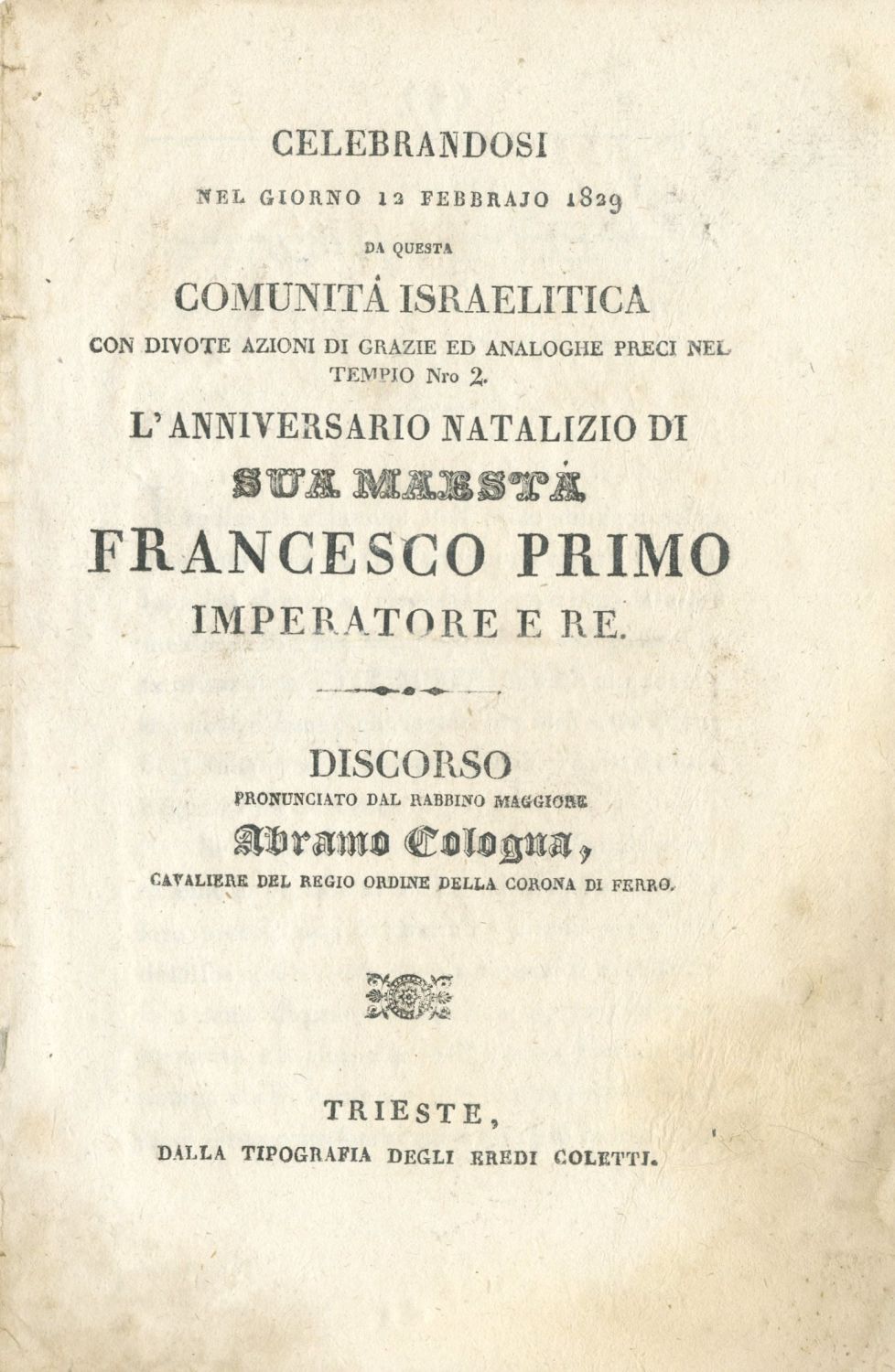
Celebrandosi nel giorno 12 febbrajo 1829 da questa comunita israelitica con divote azioni di grazie ed analogihe preci nel Tiempo Nro 2... FRANCESCO PRIMO - Sermon by the Chief Rabbi of Mantua, Rabbi Abraham Vita de Cologna, on the anniversary celebration of the birth of Emperor Francis I of Austria, King of Hungary, Bohemia and Lombardy-Venice. Trieste, February 12, 1829.
Sermon full of praise for the Emperor Francis' great wisdom, love of justice and humility.
[12] p. 23 cm. Moisture stains. Moderate condition.
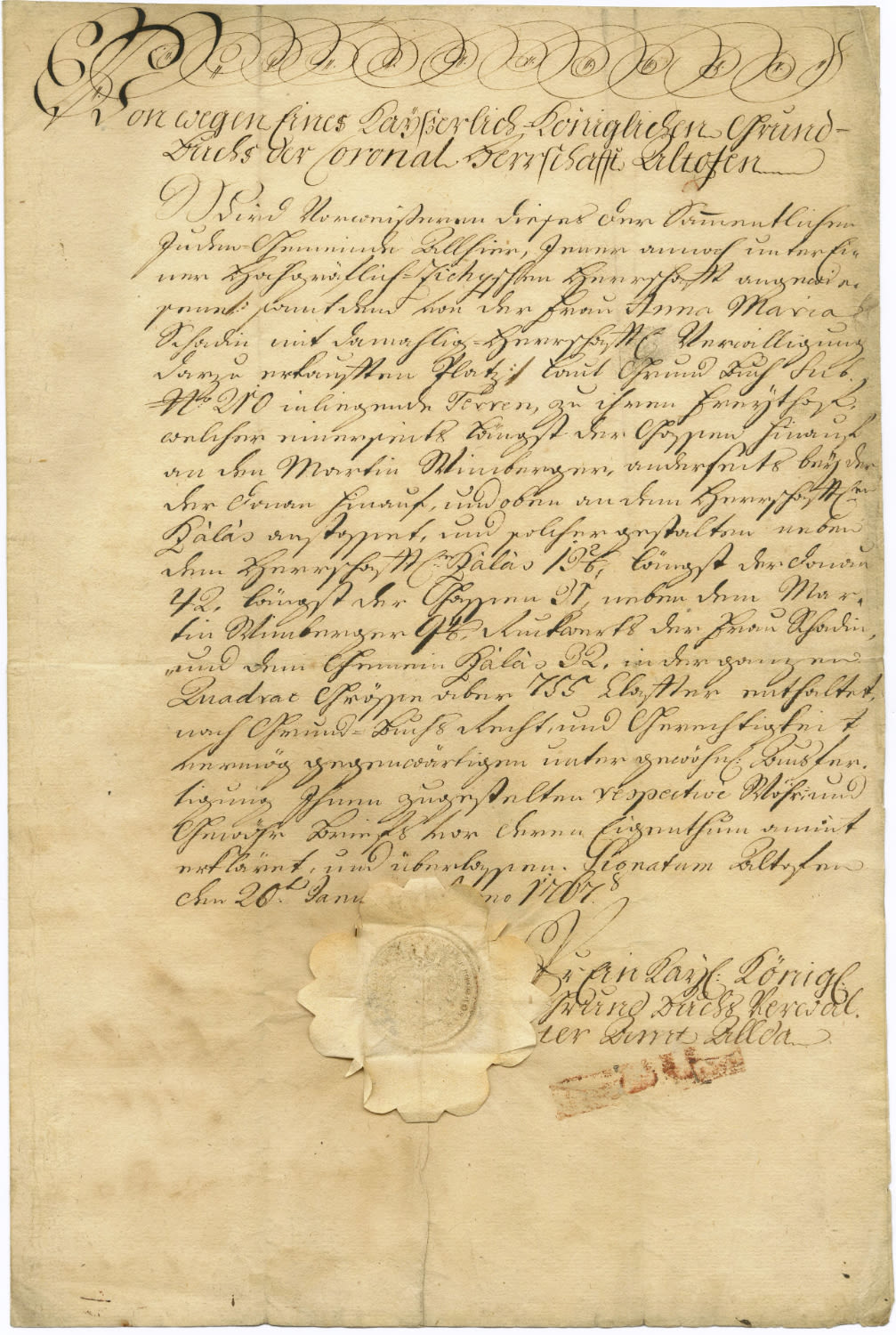
"Contract for the Jews" - an ancient handwritten document that determines the employment rights of the Jews of Alt Offen, and the manner in which they are allowed to trade with the members of the Christian community in the city. Alt-Ofen - one of the three cities that make up the historical Budapest (now Óbuda), ink on paper. 18th century. German.
In ancient times, the settlement of Jews was prohibited in the entire area known as Alt-Ofen (Óbuda in Hungarian). In 1712, Duchess Zichi invited the Jews to settle there, subject to an agreement of patronage, freedom of religion, settlement and trade conditions. To this end, in the first decades of the 18th century, official contracts were issued on behalf of the duchess to regulate the new status of the Jewish settlers. Before us a rare official document that states the various employment restrictions vis-à-vis the Christian community in the city, and the rights of the Jews of Alt-Ofen.
The arrangements with the first Jewish settlers led to a wave of immigration to Alt-Ofen, and in 1737 a synagogue was established there, and in a short time it had the largest Jewish community in Hungary! The rabbi of the community was Rabbi Moshe Mintz (died in 1831), who established a Beit Din Tzedek and a large yeshiva on the site, one of the grandest in European Jewish communities. During the 19th and 20th centuries, the community grew, and was finally destroyed in the holocaust of Hungarian Jews along with other Budapest communities.
[2] Pages, scribe's writing, royal red ink seal, and rosette paper seal. stains. Good condition.

Anti-Semitic engraving showing Shylock the Jew holding the knife in one hand and the scales in the other, from "The Merchant of Venice" J. Bell British Tabary Strand edition. London, 1785.
In this scene from the play, the greedy Jew Shylock gives the Christian Antonio three thousand ducats, and condition him with a written and signed note that if he does not pay in time, the Jew is allowed to cut off a liter of flesh from his body. Antonio lost his fortune and cannot repay the debt, and Shylock, decided to take revenge on Antonio and cut a liter of his flesh on the side of the heart. In the engraving, the Jewish Shylock is seen holding the knife in his hand and preparing to cut Antonio's flesh on the side of the heart. The play was accompanied by harsh anti-Semitic passages against the egoistic nature of the Jews, and it caused waves of anti-Semitism to erupt throughout Europe over the years, and whenever differences of opinion between Jews and Christians appeared, the play served as a background for an anti-Semitic stereotypical representation of the Jew as a threat to the decent Christian community.
15x9 cm. Light stains. Good condition.
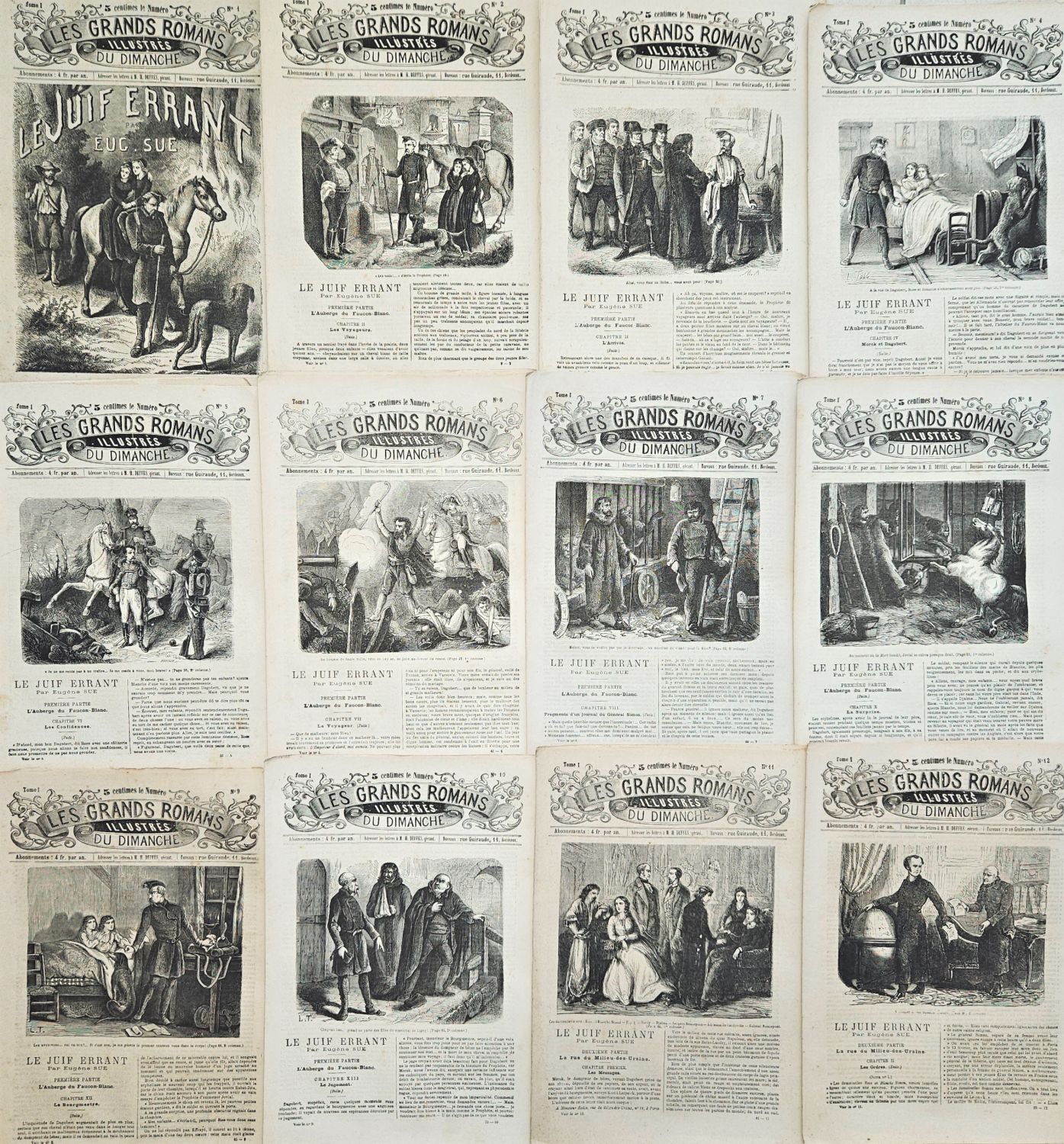
Le Juif Errant by Eugene Sue - The Wandering Jew, a French novel by Eugène Sue. LES GRANDS ROMANS ILLUSTREE DU DIMANCHE - The Great Illustrated Sunday Novels, Bordeaux, [1870]. 100 consecutive issues (not bound), missing issue 21 and issue 22.
The French novel Le Juif Errant (The Wandering Jew) by Eugène Sue, was first published in sequels in the newspaper Le Constitutionnel from June 1842 to October 1844. It was one of the most popular novels of the 19th century, and was translated into several languages. The novel tells the story of a mysterious Jew named Achashver (In the original: "Achashverosh", although the connection between the Achashverosh of the Book of Esther and the Wandering Jew is unclear), who is cursed to wander the earth forever after insulting Jesus. Achashver witnesses many historical events over centuries, including the French Revolution, the Napoleonic Wars, and the Industrial Revolution. He also intervenes in political and social causes, including the struggle for Jewish emancipation. The novel was a huge commercial success, and made Sue one of the most famous writers in France. On the title page of each issue next to the title "The Wandering Jew" is a large picture of a scene from the story, some which are antisemitic depicting the threatening Jew. Also the interior pages contain illustrations of scenes from the story.
100 consecutive issues except for issue 21 and issue 22. Issues 98, 99, 100 have an open tear with missing text in the center pages. Stains on some issues. Overall good condition.
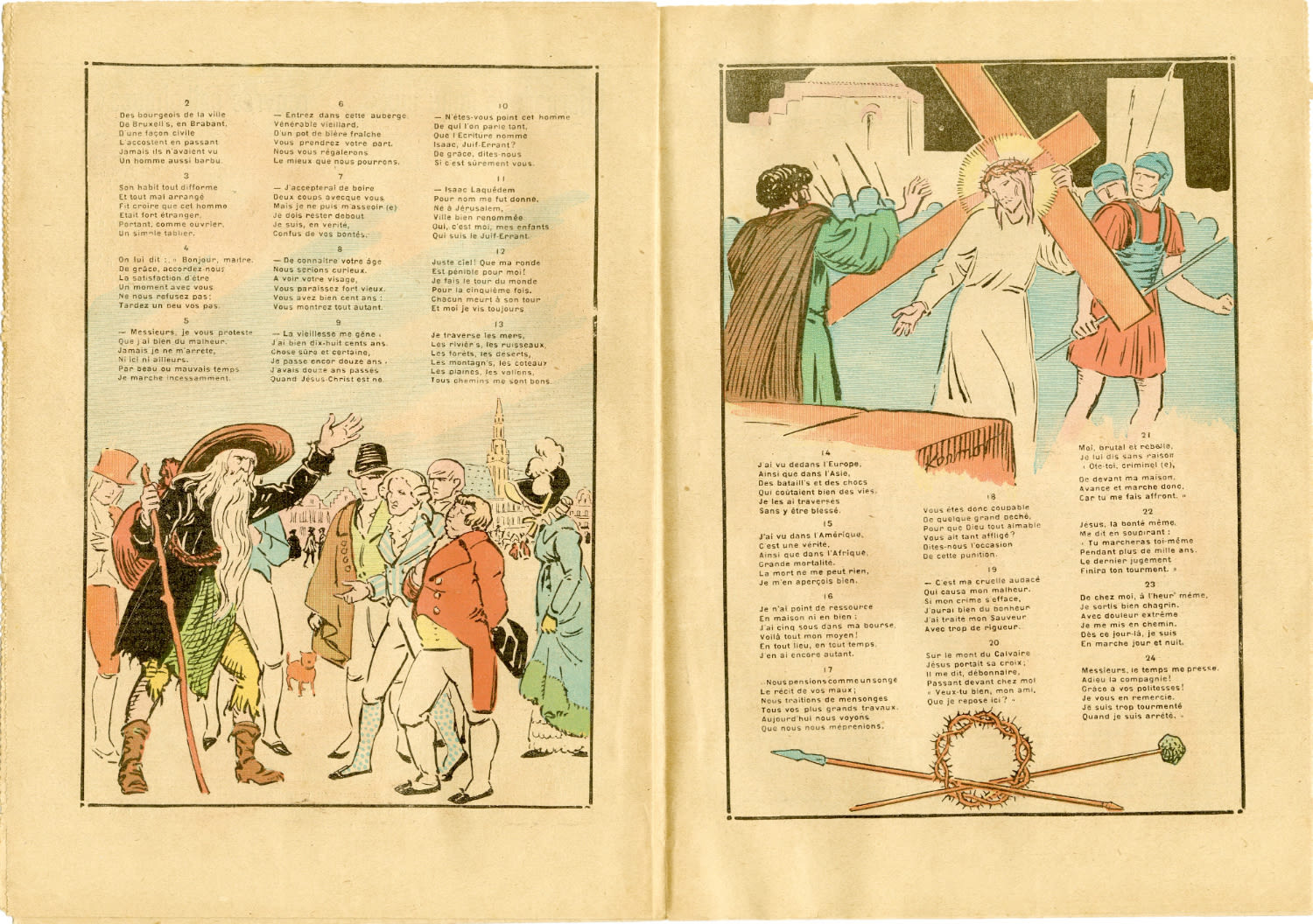
The Wandering Jew - Nine paper items - booklets, illustrated posters, postcards and cards. 19th and early 20th century.
Issue of the French Le pelerin magazine from March 25, 1896. Antisemitic caricatures. One page presents an ongoing caricature describing the sin and punishment of the Wandering Jew, and how Jesus condemned him to wander endlessly. Complete issue. Very good condition.
Four leaves from the LES VIEILLES CHANSONS series - "Old Songs" 19th century. Songs and sheet music accompanied by lithographic prints. One page presents the lyrics to the song of "The Wandering Jew" and sheet music: "I have a lot of bad luck, I never stop, neither here nor elsewhere, in good weather and bad weather, I always walk endlessly..."
Issue of the French Lecture pour tous magazine from January 1, 1917 - a long article in the middle of the issue about the return of the Wandering Jew during World War I. The article links the disasters of the war to the "return" of the Wandering Jew from history to the present. Accompanied by a silhouette image of the Wandering Jew. Complete issue. Very good condition.
Booklet No. 2 from the "Aladdin" series published by The Original Buffalo Bill Library - a colorful illustration of the Wandering Jew on the cover, and the story's heroes seen following him: "We will follow him, no matter where he goes..." This booklet incorporates the Wandering Jew into a story from the series. Complete issue.
Véritable Complainte du Juif-errant - [Lament of the Wandering Jew] - single antisemitic leaf, hand colored - France, late 19th century, from the Imagerie d'Épinal, No. 5. Published by Pellerin & Cie, [France, late 19th century]. French.
Single antisemitic leaf, with an illustration (hand colored) depicting the stereotypical figure of the Wandering Jew in worn clothes, surrounded by people in a city street. Below is a rhyming poem telling the legend of the Wandering Jew, and musical notation. 42x28 cm. Tears on margins, good condition.
Lithographic print showing a Nomad displaying an image of the Wandering Jew to European villagers. 19th century. 24x17 cm.
Issue of the French BERNADETTE, March 4, 1934. Color lithographic illustrations. Over three pages is the story of the Wandering Jew, accompanied by images of him wandering the world meeting locals, and houses of the Wandering Jew's song. Complete issue.
Advertising postcard for the play "The Wandering Jew" by Matheson lagn - the New Theater in London, 1920s.
Pocket card with lithographic illustration of the Wandering Jew. On the back is a short telling of the legend of the Wandering Jew.
Card depicting a Jewish merchant as the "Wandering Jew".
Overall very good condition.

Cinq années de ma vie 1894-1899 - Five years of my life 1894-1899. Published by Bibliotheque - Charpentier, Paris 1901 - First edition - copy signed by Captain Alfred Dreyfuss on the page next to the title page.
Dreyfus's autobiography published after his final acquittal. "I tell in these pages about my life during the five years that I was cut off from the world of the living", Dreyfus writes at the beginning of the book. In the book, Dreyfus describes the events surrounding the first trial in 1894, his conviction on the basis of the "Bordeaux Document", his deportation to Devil's Island, the retrial in Rennes, and his final acquittal. In this publication, this is the first time that the public has been exposed not only to the details of the affair that stirred the entire world, but also to the feelings of the hero behind it. In the book, Dreyfus writes most openly about the difficult feelings that accompanied him throughout the affair, his views on anti-Semitism, and the outburst of joy when he slowly realized that his path to total acquittal was assured. Dozens of letters he wrote to his wife and various people throughout the affair are quoted in full, with precise dating of each of them. Among them is one of the first letters he wrote to his wife on December 23, 1894 after his arrest, in which he marks more than anything else the struggle that had only begun in those days and ended with his total acquittal five years later: "I suffer a lot, but I feel sorry for you even more than myself... To hear all that is said about me when I know in my mind and conscience that I have never failed, I have never committed the smallest wrong... What is needed above all, whatever may happen to me, is to publish the truth, to shake the heavens and the earth so that it will be revealed... This inappropriate stain must be removed at all costs..." . The book also contains several letters from Lucy, his wife, indicating how much she stood by him throughout the affair, and how much she struggled to prove his innocence and set him free. In a letter dated December 23, 1894, she writes: "You know that I admire you, my dear husband... The terrible slander we are the object of further tightens our bonds of affection... Wherever you are sent, I will follow you... You were a martyr and you are still suffering terribly, the pain that will be caused to you is severe. Promise me you will suffer it bravely...". In the book, Dreyfus details his criticism of the French judicial system, and recounts various scenarios during the affair that were not known to the public until the publication of the book.
Alfred Dreyfus [1859-1935], a French Jewish officer in the French army, was accused of treason and espionage on false charges, in a scandal that shocked the world at the end of the 19th century. His affair was followed all along by the press, posters, public speeches, and politics, becoming a historical event with unprecedented dimensions, but after being imprisoned and going through a trial, his innocence was proven, and he was ultimately acquitted.
360 p. 19 cm. Hardcover wrapped with marble paper, slight wear on the cover. Good condition.

IL DRAMMA Alfredo Dreyfus NARRATO DA FORTUNIO ILLUSTRATO DA 124 DISEGNI - The Drama of Alfred Dreyfus, edited by Fortunio, published by SOCIETA EDITRICE SONZOGNO, MILAN 1899 - First edition. Early coverage of the affair published in Italy, a thick volume accompanied by 124 large photographs documenting the affair from its beginning to its final stages leading up to Dreyfus' final acquittal. Italian.
Extensive coverage of the Dreyfus affair in all its stages, including extensive reference to press publications published during it, outbreaks of anti-Semitism, references to secret documents that influenced the course of the trial, quotes from letters written by Dreyfus while imprisoned on Devil's Island, and the actions of prominent figures in the affair for and against Dreyfus. It was published towards the end of the affair with Dreyfus' complete acquittal, accompanied by pictures of the main characters and scenes during it. Among other things, the pictures include an extensive review of Alfred Dreyfus, starting with his enlistment in the French army, accusing him of treason through no fault of his own, the sword-breaking ceremony in the court of the École Militaire, sending him to prison, and the retrial in Rennes after the appeal against his verdict, scenes from inside the courtroom, many pictures of the defense and prosecution personnel at the trial, pictures of the heroes of the case for and against Dreyfus, and more.
VIII, 590 pages. 30 cm. Cover with illustration of Dreyfus. Stains and light wear on the cover. Slight tear with loss at the upper part of the front cover. Good condition.
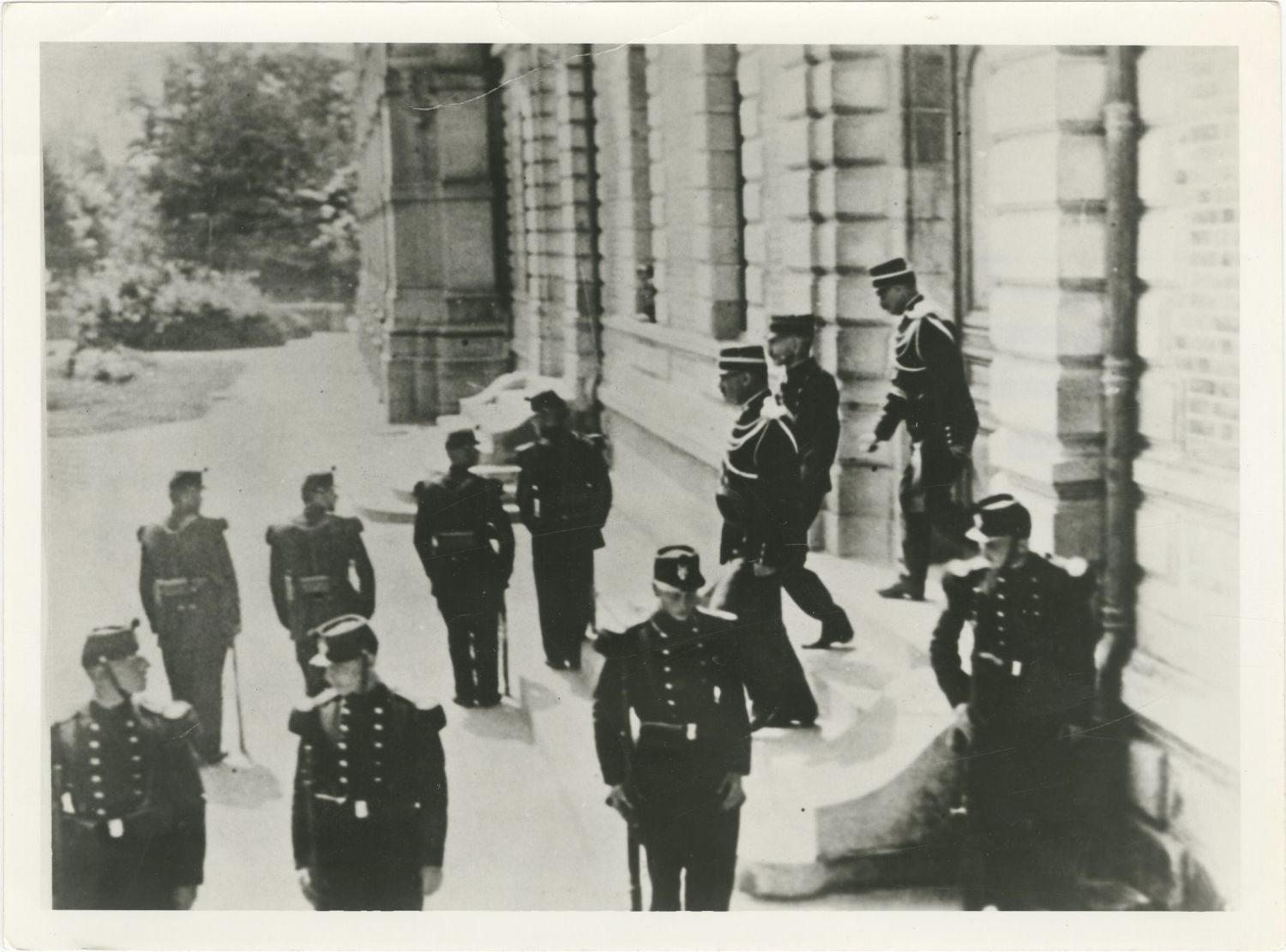
Press photograph in which Captain Alfred Dreyfus is seen leaving the courtroom of the Rennes Court House in France, on his way back to the military prison. August 7, 1899. Photo agency: Paul Popper.
This was the retrial in Rennes in which Dreyfus was "found guilty of treason with extenuating circumstances" and sentenced to ten years in prison. After ten days, and after Dreyfus agreed not to appeal the verdict, he received a pardon. In a letter from “Devil’s Island” Dreyfus wrote to his wife Lucie: “My honor belongs to me. That is the legacy I bequeath to my children. I demanded that honor from my country”.
21X16 cm. Very good condition .
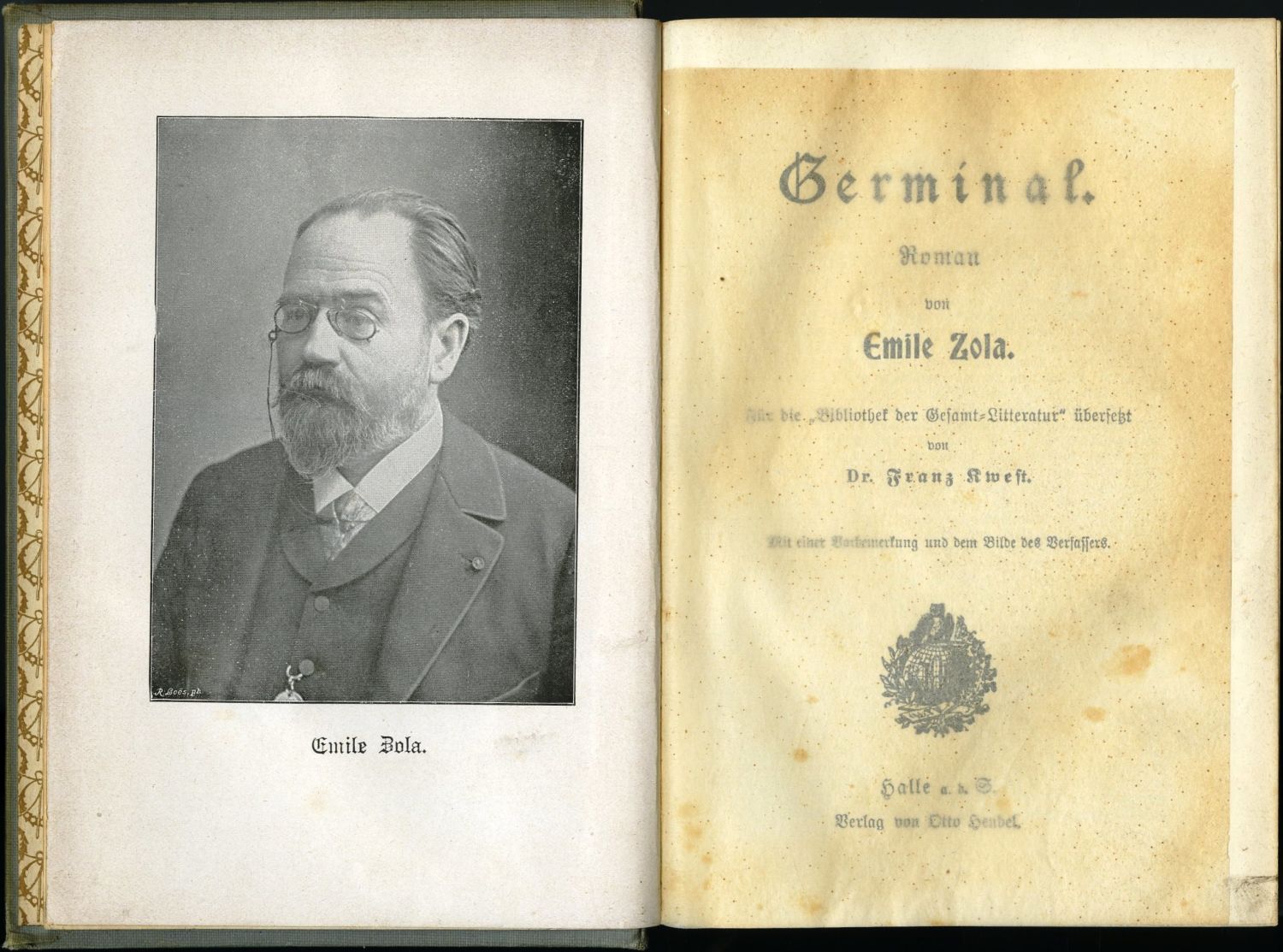
Germinal roman von Emile zola - Germinal - novel by Emile Zola. First and rare German edition [c. 1900] with a picture of Emile Zola next to the title page, published by Dalle A. D. Specially designed cover with illustration of the novel's protagonist. On the protective page is an interesting wax seal of nobility with a hand signature (not recognized by us).
Germinal is the thirteenth novel in Emile Zoola's twenty-volume series Les Rougon-Macquart. It deals with protecting the rights of coal miners in the 1860s. The townspeople's lives revolve around the mine, the schedule, and the strict rules under which they must work. Into their difficult routine appears an idealistic young man who shakes up the existing order by convincing the miners to demand the rights they deserve. The novel was published in 1885, and it was the first work in which Zola led a struggle on behalf of the weak, even before he stood by Dreyfus' side. The details surrounding the plot are based on Zola's own visits to the mining area - in 1884 Zola himself arrived at the mines in Anzin, he posed as the secretary of a member of the French Chamber of Deputies, went down to the pits dressed in city clothes, with a high stiff collar, when he noticed a horse descending into the coal tunnels, Zola asked the miners: "How do you get the horse into the mine every day and take it out?" The miners, realizing that he was asking seriously, replied: "The horse comes down here once, when he's a little foal, he grows down here, after a year or two he goes blind due to lack of light, he keeps working, until he can't work anymore, and then he's buried down here". Zola describes this scene in Germinal and hints that the horses are the miners themselves who were lowered underground as children, they have been mining coal in the pit since they were young, until they can no longer dig and there they are buried...
The novel is considered Zola's masterpiece and one of the most successful novels in the French tradition, and has been translated in over a hundred countries. At Zola's funeral, crowds of workers gathered, cheering with shouts of "Germinal! Germinal!". Since its publication until today, the book symbolizes the struggle of the workers for freedom and justice. The novel was followed by five film adaptations and two television productions.
This edition is not known in bibliographies. The WorldCat library catalog shows later German editions of the book, but this edition does not appear at all in WorldCat. (The identification of this edition as the first German edition was made based on the words of the publisher in the introduction to the book, that this is the first time that German readers will also be able to read Zola's Germinal).
488 p. 18 cm. Age stains on some pages. Good condition.
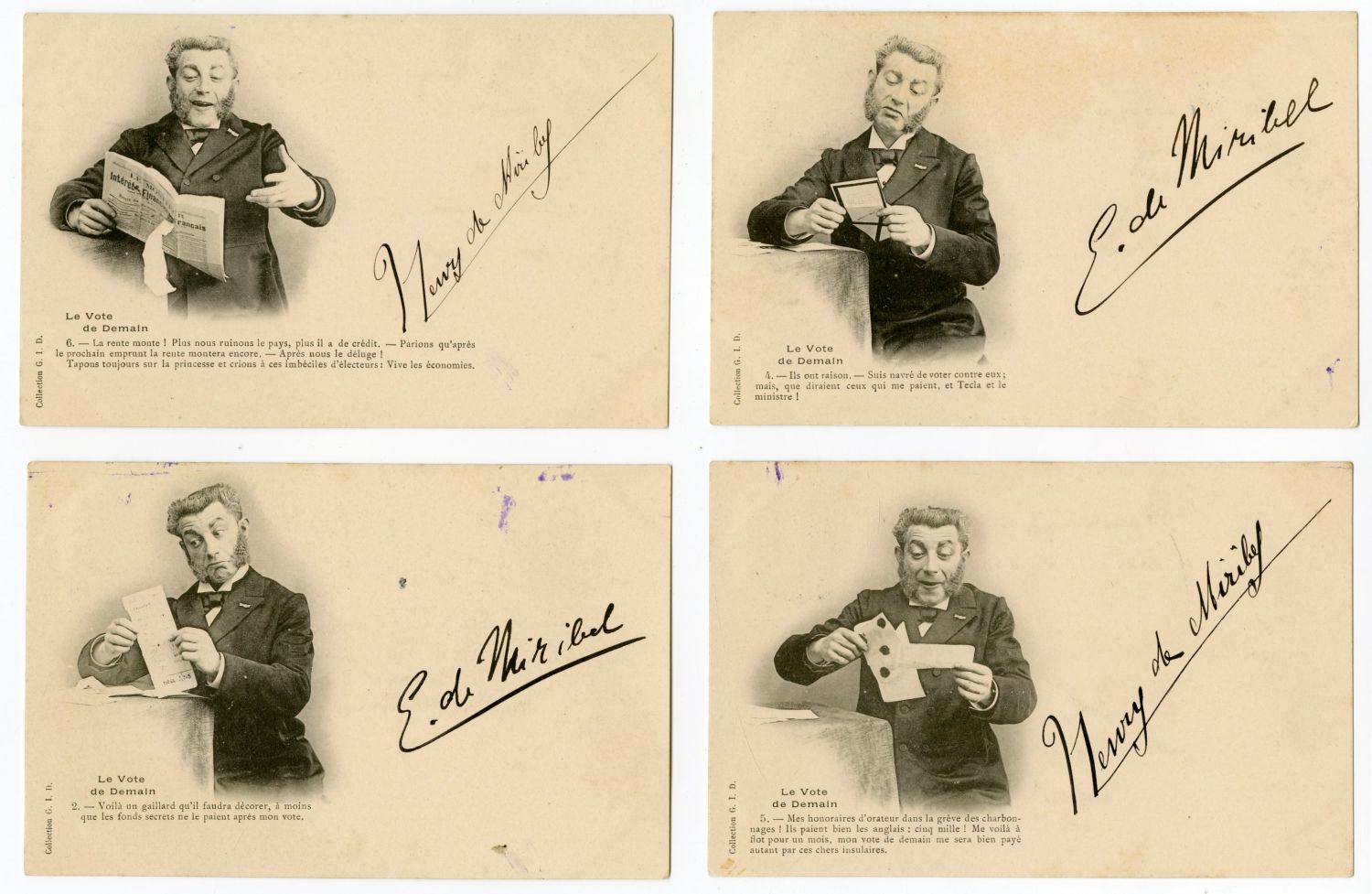
Complete set of 7 anti-Semitic postcards depicting a man sitting at his table receiving different propaganda notes in France. In each postcard the publisher puts a different sentence in his mouth dealing with the exploitation of the French state for the benefit of the Jews and Freemasons. All the postcards were mailed to the same person! Published by G.I.D. collection, France, 1902. Rare.
The figure appearing on the front of all the postcards is the same character, and the writer presents what is going through his mind, each time appearing with different facial expressions, according to the name of the candidate appearing on the right of the figure. For example, in one of the postcards it says: "My committee which is neither Jewish, nor English, nor German, tells me to vote against. What a joke to explain to him that one has to vote, ah! My brother's office will take care of it". In another postcard it says: "The rent is going up! The more we destroy the state, the more credit it has. Let's bet that after the next loan the rent will go up again. After us, the flood!", in another postcard it says: "...My voice tomorrow will be paid well by these dear islanders.", etc.
Postcards: 9x14 cm. All are undivided back. All were mailed to the same person in May, 1902. Very good condition.
Created and Develop with 🤍By webe ©2024